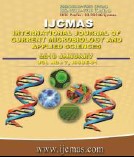


 National Academy of Agricultural Sciences (NAAS)
National Academy of Agricultural Sciences (NAAS)

|
PRINT ISSN : 2319-7692
Online ISSN : 2319-7706 Issues : 12 per year Publisher : Excellent Publishers Email : editorijcmas@gmail.com / submit@ijcmas.com Editor-in-chief: Dr.M.Prakash Index Copernicus ICV 2018: 95.39 NAAS RATING 2020: 5.38 |
Pseudomonas aeruginosa is an opportunistic pathogen and is the leading cause of nosocomial infections especially among patients admitted to ICU and burn units. It has natural resistance as well as acquired multi drug resistance to various antibiotics leading to increased morbidity and mortality. Aim of the study is to isolate P. aeruginosa from burn and ICU patients and to evaluate multidrug resistance. Samples were collected from 100 patients from both ICUs & burn unit for a period of 15 months. Samples were processed in the Microbiology laboratory by standard bacteriological methods. Growths of P. aeruginosa were tested for antibiotic susceptibility testing as per CLSI guidelines. Out of 100 patients, P. aeruginosa were recovered from burn and ICU patients 24% and 18% respectively. Resistance rates to various antibiotics in burn unit were as follows: Piperacillin/Tazobactum (33.3%), Piperacillin (75%), Aztreonam (75%), Imipenem (33.3%), Amikacin (83.3%), Ciprofloxacin (58.3%), Colistin (16.7%), Ceftazidime (75%), Cefepime (66.7%). In ICU unit resistance rates were Piperacillin/ Tazobactum (33.3%), Piperacillin (77.8%), Aztreonam (66.7%), Imipenem (22.2%), Amikacin (55.6%), Ciprofloxacin (44.4%), Colistin (11.11%), Ceftazidime (55.6%), Cefepime (44.4%). All 21% isolates were MDR patients. High rates of MDR in burn and ICU units suggest restrictions of selected antibiotics and reframing the infection control policies. A regular screening of ICU can help to combat the emergence of MDR strains of P. aeruginosa and reducing the spread of drug resistance in pathogens.
 |
 |
 |
 |
 |